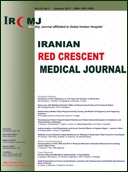Trends of Major Cardiovascular Risk Factors in Iranian Population During Years 2001-2013: The Isfahan Cohort Study
Affiliations
Abstract
Background: Trends of major cardiovascular risk factors are less investigated in Middle-Eastern countries.
Objectives: This study aimed to assess the trend of major cardiovascular risk factors among Iranian individuals.
Methods: This Longitudinal population-based study was performed by multistage random sampling on 6504 participants aged at
least 35 years for 12 years initiating in 2001 until 2013 in three phases. Cardiovascular risk factors including systolic blood pressure
(SBP), diastolic blood pressure (DBP), waist circumference (WC), waist to hip ratio (WHR), body mass index (BMI), fasting blood sugar
(FBS) and lipid indices were measured for each subject in 2001, 2007 and 2013 and were analyzed using repeated measure analysis
of variance using Bonferroni correction.
Results: Mean value of SBP, DBP, BMI and FBS increased significantly in both genders during follow-up (SBP: 119.3 ± 18.7 to 128.4
± 17.5 mmHg, P value < 0.001, DBP: 76.7 ± 11.8 to 82.8 ± 12.5 mmHg, P value < 0.001, BMI: 27.4 ± 4.4 to 28 ± 4.6 kg/m2
, P value <
0.001, FBS: 86.7 ± 29.6 to 106.5 ± 38 mg/dL, P value < 0.001). Lipid profiles including total cholesterol (TC), triglyceride (TG), lowdensity lipoprotein cholesterol (LDL-C) and TG/ high-density lipoprotein cholesterol (HDL-C) showed favorable downward patterns
in population (TC: 219.5±51.3 to 200.1±40.9 mg/dL, P value < 0.001, TG: 200.2±110.3 to 155.1±85 mg/dL, P value < 0.001, LDL-C: 132.6
± 42.4 to 111.7 ± 27.8 mg/dL, P value < 0.001, TG/HDL-C: 4.5 ± 2.8 to 3.9 ± 2.8, P value < 0.001) with an exception of HDL-C showing
less desirable results. In spite of controversial results in terms of WC and WHR changes relative to gender, total population changes
of those variables were not significant.
Conclusions: Although favorable patterns were observed in most lipid indices, other risk factors showed an inverse or insignificant
trend. Several health-promoting strategies are required in order to improve lifestyle in a way that those raising cardiovascular risk
factor trends would decline.
Keywords: Blood Glucose, Blood Pressure, Body Mass Index, Cardiovascular Diseases, Cohort Study, Iran, Life Style, Lipids, Risk
Factors, Waist Circumference, Waist-Hip Rati

